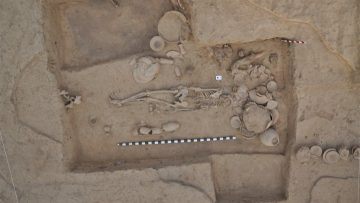Sarah Zhang in The Atlantic:
 The climate of South Asia is not kind to ancient DNA. It is hot and it rains. In monsoon season, water seeps into ancient bones in the ground, degrading the old genetic material. So by the time archeologists and geneticists finally got DNA out of a tiny ear bone from a 4,000-plus-year-old skeleton, they had already tried dozens of samples—all from cemeteries of the mysterious Indus Valley civilization, all without any success. The Indus Valley civilization, also known as the Harappan civilization, flourished 4,000 years ago in what is now India and Pakistan. It surpassed its contemporaries, Mesopotamia and ancient Egypt, in size. Its trade routes stretched thousands of miles. It had agriculture and planned cities and sewage systems. And then, it disappeared. “The Indus Valley civilization has been an enigma for South Asians. We read about it in our textbooks,” says Priya Moorjani, a computational biologist at the University of California at Berkeley. “The end of the civilization was quite mysterious.” No one alive today is sure who the people of the Indus Valley civilization were or where they went.
The climate of South Asia is not kind to ancient DNA. It is hot and it rains. In monsoon season, water seeps into ancient bones in the ground, degrading the old genetic material. So by the time archeologists and geneticists finally got DNA out of a tiny ear bone from a 4,000-plus-year-old skeleton, they had already tried dozens of samples—all from cemeteries of the mysterious Indus Valley civilization, all without any success. The Indus Valley civilization, also known as the Harappan civilization, flourished 4,000 years ago in what is now India and Pakistan. It surpassed its contemporaries, Mesopotamia and ancient Egypt, in size. Its trade routes stretched thousands of miles. It had agriculture and planned cities and sewage systems. And then, it disappeared. “The Indus Valley civilization has been an enigma for South Asians. We read about it in our textbooks,” says Priya Moorjani, a computational biologist at the University of California at Berkeley. “The end of the civilization was quite mysterious.” No one alive today is sure who the people of the Indus Valley civilization were or where they went.
A pair of newly published papers use ancient DNA to shed light on the Indus Valley civilization and the entire history of people in South and Central Asia. The first study is a sweeping collection of 523 genomes—300 to 12,000 years old—from a region spanned by Iran, Russia, and India. By comparing the results with modern South Asians’ genomes, the study showed that South Asians today descended from a mix of local hunter-gatherers, Iranian-related groups, and steppe pastoralists who came by way of Central Asia. It’s the largest number of ancient genomes reported in a single paper, all made possible by an ancient DNA “factory” the geneticist David Reich has built at Harvard. (Moorjani completed her doctorate in Reich’s lab and is a co-author on this paper.)
More here.
